Advances in Flexible Organic Photodetectors: Materials and Applications
Abstract
1. Introduction
2. Flexible OPD Background
2.1. Flexible OPD Working Principle
2.2. Flexible OPD Configuration
2.2.1. Organic Photodiodes
2.2.2. Organic Photoconductors
2.2.3. Organic Phototransistors
2.3. Figure of Merits
2.3.1. Optoelectronic Performance
EQE and Responsivity
Response Time
Noise
Specific Detectivity
2.3.2. Stability and Durability
3. Flexible OPDs Advances
3.1. Flexible Substrate
3.2. Transparent Conductive Electrodes
3.3. Active Layers
3.3.1. Organic Materials
Small Molecules
Polymers
Dyes
Elastomers
3.3.2. Hybrid Active Layers
Polymers and Perovskites
Polymers and Inorganic Materials
Polymer and Two-Dimensional-Based Materials
4. Applications
4.1. Health Monitoring
4.2. Image Sensors
4.3. X-ray Detectors
5. Discussion
6. Conclusions
Author Contributions
Funding
Data Availability Statement
Conflicts of Interest
References
- Lv, C.; Hu, C.; Luo, J.; Liu, S.; Qiao, Y.; Zhang, Z.; Song, J.; Shi, Y.; Cai, J.; Watanabe, A. Recent Advances in Graphene-Based Humidity Sensors. Nanomaterials 2019, 9, 422. [Google Scholar] [CrossRef] [PubMed]
- Dastgeer, G.; Shahzad, Z.M.; Chae, H.; Kim, Y.H.; Ko, B.M.; Eom, J. Bipolar Junction Transistor Exhibiting Excellent Output Characteristics with a Prompt Response against the Selective Protein. Adv. Funct. Mater. 2022, 32. [Google Scholar] [CrossRef]
- Dastgeer, G.; Afzal, A.M.; Aziz, J.; Hussain, S.; Jaffery, S.H.A.; Kim, D.K.; Imran, M.; Assiri, M.A. Flexible Memory Device Composed of Metal-Oxide and Two-Dimensional Material (SnO2/WTe2) Exhibiting Stable Resistive Switching. Materials 2021, 14, 7535. [Google Scholar] [CrossRef] [PubMed]
- Nabavi, S.; Bhadra, S. Flexible Inductive Wireless Power Transfer System with an Onboard Temperature Sensor. In Proceedings of the 2021 IEEE International Conference on Flexible and Printable Sensors and Systems (FLEPS), Manchester, UK, 20–23 June 2021; pp. 1–4. [Google Scholar]
- Debbarma, S.; Bhadra, S. A Flexible Wearable Electrooculogram System with Motion Artifacts Sensing and Reduction. IEEE Trans. Biomed. Circuits Syst. 2022, 16, 324–335. [Google Scholar] [CrossRef] [PubMed]
- Nabavi, S.; Chen, Y.; Lasry, N.; Bhadra, S. Fully Flexible Organic LED Fabricated by a Solution-based Process. In Proceedings of the 2022 IEEE International Conference on Flexible and Printable Sensors and Systems (FLEPS), Vienna, Austria, 10 June 2022; pp. 1–4. [Google Scholar]
- Song, Y.M.; Xie, Y.; Malyarchuk, V.; Xiao, J.; Jung, I.; Choi, K.-J.; Liu, Z.; Park, H.; Lu, C.; Kim, R.-H.; et al. Digital cameras with designs inspired by the arthropod eye. Nature 2013, 497, 95–99. [Google Scholar] [CrossRef]
- Kim, D.-H.; Viventi, J.; Amsden, J.J.; Xiao, J.; Vigeland, L.; Kim, Y.-S.; Blanco, J.A.; Panilaitis, B.; Frechette, E.S.; Contreras, D.; et al. Dissolvable films of silk fibroin for ultrathin conformal bio-integrated electronics. Nat. Mater. 2010, 9, 511–517. [Google Scholar] [CrossRef]
- Yokota, T.; Zalar, P.; Kaltenbrunner, M.; Jinno, H.; Matsuhisa, N.; Kitanosako, H.; Tachibana, Y.; Yukita, W.; Koizumi, M.; Someya, T. Ultraflexible organic photonic skin. Sci. Adv. 2016, 2, e1501856. [Google Scholar] [CrossRef]
- Jinno, H.; Fukuda, K.; Xu, X.; Park, S.; Suzuki, Y.; Koizumi, M.; Yokota, T.; Osaka, I.; Takimiya, K.; Someya, T. Stretchable and waterproof elastomer-coated organic photovoltaics for washable electronic textile applications. Nat. Energy 2017, 2, 780–785. [Google Scholar] [CrossRef]
- Kim, J.; Kwon, S.-M.; Kang, Y.K.; Kim, Y.-H.; Lee, M.-J.; Han, K.; Facchetti, A.; Kim, M.-G.; Park, S.K. A skin-like two-dimensionally pixelized full-color quantum dot photodetector. Sci. Adv. 2019, 5, eaax8801. [Google Scholar] [CrossRef]
- Konstantatos, G.; Howard, I.; Fischer, A.; Hoogland, S.; Clifford, J.P.; Klem, E.J.D.; Levina, L.; Sargent, E.H. Ultrasensitive solution-cast quantum dot photodetectors. Nature 2006, 442, 180–183. [Google Scholar] [CrossRef]
- Yang, J.; Choi, M.K.; Yang, U.J.; Kim, S.Y.; Kim, Y.S.; Kim, J.H.; Kim, D.-H.; Hyeon, T. Toward Full-Color Electroluminescent Quantum Dot Displays. Nano Lett. 2020, 21, 26–33. [Google Scholar] [CrossRef]
- Gu, L.; Poddar, S.; Lin, Y.; Long, Z.; Zhang, D.; Zhang, Q.; Shu, L.; Qiu, X.; Kam, M.; Javey, A.; et al. A biomimetic eye with a hemispherical perovskite nanowire array retina. Nature 2020, 581, 278–282. [Google Scholar] [CrossRef]
- Peng, Z.-Y.; Xu, J.-L.; Zhang, J.-Y.; Gao, X.; Wang, S.-D. Solution-Processed High-Performance Hybrid Photodetectors Enhanced by Perovskite/MoS2 Bulk Heterojunction. Adv. Mater. Interfaces 2018, 5. [Google Scholar] [CrossRef]
- Lee, W.; Lee, J.; Yun, H.; Kim, J.; Park, J.; Choi, C.; Kim, D.C.; Seo, H.; Lee, H.; Yu, J.W.; et al. High-resolution spin-on-patterning of perovskite thin films for a multiplexed image sensor array. Adv. Mater. 2017, 29, 1702902. [Google Scholar] [CrossRef]
- Khan, M.F.; Ahmed, F.; Rehman, S.; Akhtar, I.; Rehman, M.A.; Shinde, P.A.; Khan, K.; Kim, D.-K.; Eom, J.; Lipsanen, H.; et al. High performance complementary WS2 devices with hybrid Gr/Ni contacts. Nanoscale 2020, 12, 21280–21290. [Google Scholar] [CrossRef]
- Sun, Z.; Yu, P.; Wang, F.; Wang, F.; Yao, Y.; Zhan, X.; Wang, Z.; He, J. High-performance ultraviolet photodetectors based on 2D layered In4/3P2Se6 nanoflakes. Appl. Phys. Lett. 2022, 120, 103506. [Google Scholar] [CrossRef]
- Choi, S.; Lee, H.; Ghaffari, R.; Hyeon, T.; Kim, D.-H. Recent Advances in Flexible and Stretchable Bio-Electronic Devices Integrated with Nanomaterials. Adv. Mater. 2016, 28, 4203–4218. [Google Scholar] [CrossRef]
- Lan, Z.; Lee, M.-H.; Zhu, F. Recent Advances in Solution-Processable Organic Photodetectors and Applications in Flexible Electronics. Adv. Intell. Syst. 2021, 4, 2100167. [Google Scholar] [CrossRef]
- Dong, T.; Simões, J.; Yang, Z. Flexible photodetector based on 2D materials: Processing, architectures, and applications. Adv. Mater. Interfaces 2020, 7, 1901657. [Google Scholar] [CrossRef]
- Chow, P.C.Y.; Someya, T. Organic Photodetectors for Next-Generation Wearable Electronics. Adv. Mater. 2019, 32, e1902045. [Google Scholar] [CrossRef]
- Jang, W.; Kim, B.G.; Seo, S.; Shawky, A.; Kim, M.S.; Kim, K.; Mikladal, B.; Kauppinen, E.I.; Maruyama, S.; Jeon, I.; et al. Strong dark current suppression in flexible organic photodetectors by carbon nanotube transparent electrodes. Nano Today 2021, 37, 101081. [Google Scholar] [CrossRef]
- Song, J.-K.; Kim, M.S.; Yoo, S.; Koo, J.H.; Kim, D.-H. Materials and devices for flexible and stretchable photodetectors and light-emitting diodes. Nano Res. 2021, 14, 2919–2937. [Google Scholar] [CrossRef]
- Ren, H.; Chen, J.; Li, Y.; Tang, J. Recent Progress in Organic Photodetectors and their Applications. Adv. Sci. 2020, 8. [Google Scholar] [CrossRef] [PubMed]
- Brédas, J.-L.; Norton, J.E.; Cornil, J.; Coropceanu, V. Molecular Understanding of Organic Solar Cells: The Challenges. Accounts Chem. Res. 2009, 42, 1691–1699. [Google Scholar] [CrossRef] [PubMed]
- Yu, G.; Gao, J.; Hummelen, J.C.; Wudl, F.; Heeger, A.J. Polymer Photovoltaic Cells: Enhanced Efficiencies via a Network of Internal Donor-Acceptor Heterojunctions. Science 1995, 270, 1789–1791. [Google Scholar] [CrossRef]
- Halls, J.J.M.; Walsh, C.A.; Greenham, N.C.; Marseglia, E.A.; Friend, R.H.; Moratti, S.C.; Holmes, A.B. Efficient photodiodes from interpenetrating polymer networks. Nature 1995, 376, 498–500. [Google Scholar] [CrossRef]
- Chow, P.C.Y.; Bayliss, S.L.; Lakhwani, G.; Greenham, N.C.; Friend, R.H. In Situ Optical Measurement of Charge Transport Dynamics in Organic Photovoltaics. Nano Lett. 2015, 15, 931–935. [Google Scholar] [CrossRef]
- Torsi, L.; Magliulo, M.; Manoli, K.; Palazzo, G. Organic field-effect transistor sensors: A tutorial review. Chem. Soc. Rev. 2013, 42, 8612–8628. [Google Scholar] [CrossRef]
- Vandewal, K. Interfacial Charge Transfer States in Condensed Phase Systems. Annu. Rev. Phys. Chem. 2016, 67, 113–133. [Google Scholar] [CrossRef]
- Vandewal, K.; Ma, Z.; Bergqvist, J.; Tang, Z.; Wang, E.; Henriksson, P.; Tvingstedt, K.; Andersson, M.R.; Zhang, F.; Inganäs, O. Quantification of Quantum Efficiency and Energy Losses in Low Bandgap Polymer:Fullerene Solar Cells with High Open-Circuit Voltage. Adv. Funct. Mater. 2012, 22, 3480–3490. [Google Scholar] [CrossRef]
- Cnops, K.; Rand, B.; Cheyns, D.; Verreet, B.; Empl, M.A.; Heremans, P. 8.4% efficient fullerene-free organic solar cells exploiting long-range exciton energy transfer. Nat. Commun. 2014, 5, 3406. [Google Scholar] [CrossRef]
- Kuribara, K.; Wang, H.; Uchiyama, N.; Fukuda, K.; Yokota, T.; Zschieschang, U.; Jaye, C.; Fischer, D.A.; Klauk, H.; Yamamoto, T.; et al. Organic transistors with high thermal stability for medical applications. Nat. Commun. 2012, 3, 723. [Google Scholar] [CrossRef]
- Zhang, G.; Zhao, J.; Chow, P.C.Y.; Jiang, K.; Zhang, J.; Zhu, Z.; Zhang, J.; Huang, F.; Yan, H. Nonfullerene Acceptor Molecules for Bulk Heterojunction Organic Solar Cells. Chem. Rev. 2018, 118, 3447–3507. [Google Scholar] [CrossRef]
- Liu, C.K.; Tai, Q.; Wang, N.; Tang, G.; Hu, Z.; Yan, F. Lead-Free Perovskite/Organic Semiconductor Vertical Heterojunction for Highly Sensitive Photodetectors. ACS Appl. Mater. Interfaces 2020, 12, 18769–18776. [Google Scholar] [CrossRef]
- Shi, L.; Song, J.; Zhang, Y.; Li, G.; Wang, W.; Hao, Y.; Wu, Y.; Cui, Y. High performance flexible organic photomultiplication photodetector based on an ultra-thin silver film transparent electrode. Nanotechnology 2020, 31, 314001. [Google Scholar] [CrossRef]
- Van Breemen, A.J.; Simon, M.; Tousignant, O.; Shanmugam, S.; van der Steen, J.L.; Akkerman, H.B.; Kronemeijer, A.; Ruetten, W.; Raaijmakers, R.; Alving, L.; et al. Curved digital X-ray detectors. npj Flex. Electron. 2020, 4, 1–8. [Google Scholar] [CrossRef]
- Lv, L.; Dang, W.; Wu, X.; Chen, H.; Wang, T.; Qin, L.; Wei, Z.; Zhang, K.; Shen, G.; Huang, H. Flexible Short-Wave Infrared Image Sensors Enabled by High-Performance Polymeric Photodetectors. Macromolecules 2020, 53, 10636–10643. [Google Scholar] [CrossRef]
- Xia, Y.; Aguirre, L.E.; Xu, X.; Inganäs, O. All-Polymer High-Performance Photodetector through Lamination. Adv. Electron. Mater. 2020, 6, 1–7. [Google Scholar] [CrossRef]
- Wei, Y.; Chen, H.; Liu, T.; Wang, S.; Jiang, Y.; Song, Y.; Zhang, J.; Zhang, X.; Lu, G.; Huang, F.; et al. Self-Powered Organic Photodetectors with High Detectivity for Near Infrared Light Detection Enabled by Dark Current Reduction. Adv. Funct. Mater. 2021, 31, 2106326. [Google Scholar] [CrossRef]
- Large, M.J.; Posar, J.A.; Mozer, A.J.; Nattestad, A.; Alnaghy, S.; Carolan, M.; Sellin, P.J.; Davies, J.; Pastuovic, Z.; Lerch, M.L.F.; et al. Flexible Polymer X-ray Detectors with Non-fullerene Acceptors for Enhanced Stability: Toward Printable Tissue Equivalent Devices for Medical Applications. ACS Appl. Mater. Interfaces 2021, 13, 57703–57712. [Google Scholar] [CrossRef]
- Jiang, Z.; Yu, K.; Wang, H.; Rich, S.; Yokota, T.; Fukuda, K.; Someya, T. Ultraflexible Integrated Organic Electronics for Ultrasensitive Photodetection. Adv. Mater. Technol. 2020, 6, 2000956. [Google Scholar] [CrossRef]
- Li, Q.; Ran, Y.; Shi, W.; Qin, M.; Sun, Y.; Kuang, J.; Wang, H.; Chen, H.; Guo, Y.; Liu, Y. High-performance near-infrared polymeric phototransistors realized by combining cross-linked polymeric semiconductors and bulk heterojunction bilayer structures. Appl. Mater. Today 2020, 22, 100899. [Google Scholar] [CrossRef]
- Huang, H.; Jiang, L.; Peng, J.; Qi, Y.; Bai, S.; Lin, Q. High-Performance Organic Phototransistors Based on D18, a High-Mobility and Unipolar Polymer. Chem. Mater. 2021, 33, 8089–8096. [Google Scholar] [CrossRef]
- Li, D.; Du, J.; Tang, Y.; Liang, K.; Wang, Y.; Ren, H.; Wang, R.; Meng, L.; Zhu, B.; Li, Y. Flexible and Air-Stable Near-Infrared Sensors Based on Solution-Processed Inorganic–Organic Hybrid Phototransistors. Adv. Funct. Mater. 2021, 31, 1–10. [Google Scholar] [CrossRef]
- Kim, J.H.; Liess, A.; Stolte, M.; Krause, A.; Stepanenko, V.; Zhong, C.; Bialas, D.; Spano, F.; Würthner, F. An Efficient Narrowband Near-Infrared at 1040 nm Organic Photodetector Realized by Intermolecular Charge Transfer Mediated Coupling Based on a Squaraine Dye. Adv. Mater. 2021, 33, 2100582. [Google Scholar] [CrossRef]
- Zhang, J.; Zhong, W.; Liu, Y.; Huang, J.; Deng, S.; Zhang, M.; Kwok, H.; Li, G. A High-Performance Photodetector Based on 1D Perovskite Radial Heterostructure. Adv. Opt. Mater. 2021, 9, 2101504. [Google Scholar] [CrossRef]
- Park, Y.; Fuentes-Hernandez, C.; Kim, K.; Chou, W.-F.; Larrain, F.A.; Graham, S.; Pierron, O.N.; Kippelen, B. Skin-like low-noise elastomeric organic photodiodes. Sci. Adv. 2021, 7, eabj6565. [Google Scholar] [CrossRef]
- Ge, Z.; Xu, N.; Zhu, Y.; Zhao, K.; Ma, Y.; Li, G.; Chen, Y. Visible to Mid-Infrared Photodetection Based on Flexible 3D Graphene/Organic Hybrid Photodetector with Ultrahigh Responsivity at Ambient Conditions. ACS Photon. 2022, 9, 59–67. [Google Scholar] [CrossRef]
- Simões, J.; Dong, T.; Yang, Z. Non-Fullerene Acceptor Organic Photodetector for Skin-Conformable Photoplethysmography Applications. Adv. Mater. Interfaces 2022, 9, 2101897. [Google Scholar] [CrossRef]
- Reddy, B.K.S.; Veeralingam, S.; Borse, P.H.; Badhulika, S. A flexible, rapid response, hybrid inorganic–organic SnSe 2 –PEDOT:PSS bulk heterojunction based high-performance broadband photodetector. Mater. Chem. Front. 2022, 6, 341–351. [Google Scholar] [CrossRef]
- Du, X.; Tian, W.; Pan, J.; Hui, B.; Sun, J.; Zhang, K.; Xia, Y. Piezo-phototronic effect promoted carrier separation in coaxial p-n junctions for self-powered photodetector. Nano Energy 2021, 92, 106694. [Google Scholar] [CrossRef]
- Hu, C.; Chen, H.; Li, L.; Huang, H.; Shen, G. Ti3C2Tx MXene-RAN van der Waals Heterostructure-Based Flexible Transparent NIR Photodetector Array for 1024 Pixel Image Sensing Application. Adv. Mater. Technol. 2022, 2101639, 1–9. [Google Scholar]
- Munzenrieder, N.; Zysset, C.; Kinkeldei, T.; Troster, G. Design Rules for IGZO Logic Gates on Plastic Foil Enabling Operation at Bending Radii of 3.5 mm. IEEE Trans. Electron Devices 2012, 59, 2153–2159. [Google Scholar] [CrossRef]
- Takei, K.; Takahashi, T.; Ho, J.C.; Ko, H.; Gillies, A.G.; Leu, P.W.; Fearing, R.S.; Javey, A. Nanowire active-matrix circuitry for low-voltage macroscale artificial skin. Nat. Mater. 2010, 9, 821–826. [Google Scholar] [CrossRef]
- Liu, X.; Wang, C.; Cai, B.; Xiao, X.; Guo, S.; Fan, Z.; Li, J.; Duan, X.; Liao, L. Rational Design of Amorphous Indium Zinc Oxide/Carbon Nanotube Hybrid Film for Unique Performance Transistors. Nano Lett. 2012, 12, 3596–3601. [Google Scholar] [CrossRef]
- Wang, C.; Chien, J.-C.; Takei, K.; Takahashi, T.; Nah, J.; Niknejad, A.M.; Javey, A. Extremely Bendable, High-Performance Integrated Circuits Using Semiconducting Carbon Nanotube Networks for Digital, Analog, and Radio-Frequency Applications. Nano Lett. 2012, 12, 1527–1533. [Google Scholar] [CrossRef]
- Yi, H.T.; Payne, M.M.; Anthony, J.; Podzorov, V. Ultra-flexible solution-processed organic field-effect transistors. Nat. Commun. 2012, 3, 1259. [Google Scholar] [CrossRef]
- Sekitani, T.; Zschieschang, U.; Klauk, H.; Someya, T. Flexible organic transistors and circuits with extreme bending stability. Nat. Mater. 2010, 9, 1015–1022. [Google Scholar] [CrossRef]
- Zhang, L.; Wang, H.; Zhao, Y.; Guo, Y.; Hu, W.; Yu, G.; Liu, Y. Substrate-Free Ultra-Flexible Organic Field-Effect Transistors and Five-Stage Ring Oscillators. Adv. Mater. 2013, 25, 5455–5460. [Google Scholar] [CrossRef]
- Khodagholy, D.; Rivnay, J.; Sessolo, M.; Gurfinkel, M.; Leleux, P.; Jimison, L.H.; Stavrinidou, E.; Herve, T.; Sanaur, S.; Owens, R.; et al. High transconductance organic electrochemical transistors. Nat. Commun. 2013, 4, 2133. [Google Scholar] [CrossRef]
- Kim, D.-H.; Ahn, J.-H.; Choi, W.M.; Kim, H.-S.; Kim, T.-H.; Song, J.; Huang, Y.Y.; Liu, Z.; Lu, C.; Rogers, J.A. Stretchable and Foldable Silicon Integrated Circuits. Nature 2008, 320, 507–511. [Google Scholar] [CrossRef] [PubMed]
- Kaltenbrunner, M.; White, M.; Głowacki, E.D.; Sekitani, T.; Someya, T.; Sariciftci, N.S.; Bauer, S. Ultrathin and lightweight organic solar cells with high flexibility. Nat. Commun. 2012, 3, 770. [Google Scholar] [CrossRef] [PubMed]
- Kaltenbrunner, M.; Sekitani, T.; Reeder, J.; Yokota, T.; Kuribara, K.; Tokuhara, T.; Drack, M.; Schwödiauer, R.; Graz, I.; Bauer-Gogonea, S.; et al. An ultra-lightweight design for imperceptible plastic electronics. Nature 2013, 499, 458–463. [Google Scholar] [CrossRef] [PubMed]
- Khodagholy, D.; Doublet, T.; Quilichini, P.; Gurfinkel, M.; LeLeux, P.; Ghestem, A.; Ismailova, E.; Hervé, T.; Sanaur, S.; Bernard, C. In vivo recordings of brain activity using organic transistors. Nat. Commun. 2013, 4, 1–7. [Google Scholar] [CrossRef] [PubMed]
- Jiang, D.-H.; Liao, Y.-C.; Cho, C.-J.; Veeramuthu, L.; Liang, F.-C.; Wang, T.-C.; Chueh, C.-C.; Satoh, T.; Tung, S.-H.; Kuo, C.-C. Facile Fabrication of Stretchable Touch-Responsive Perovskite Light-Emitting Diodes Using Robust Stretchable Composite Electrodes. ACS Appl. Mater. Interfaces 2020, 12, 14408–14415. [Google Scholar] [CrossRef]
- Shin, M.; Song, J.H.; Lim, G.-H.; Lim, B.; Park, J.-J.; Jeong, U. Highly Stretchable Polymer Transistors Consisting Entirely of Stretchable Device Components. Adv. Mater. 2014, 26, 3706–3711. [Google Scholar] [CrossRef]
- Wang, S.; Xu, J.; Wang, W.; Wang, G.-J.N.; Rastak, R.; Molina-Lopez, F.; Chung, J.W.; Niu, S.; Feig, V.R.; Lopez, J.; et al. Skin electronics from scalable fabrication of an intrinsically stretchable transistor array. Nature 2018, 555, 83–88. [Google Scholar] [CrossRef]
- Lee, P.; Lee, J.; Lee, H.; Yeo, J.; Hong, S.; Nam, K.H.; Lee, D.; Lee, S.S.; Ko, S.H. Highly Stretchable and Highly Conductive Metal Electrode by Very Long Metal Nanowire Percolation Network. Adv. Mater. 2012, 24, 3326–3332. [Google Scholar] [CrossRef]
- Kim, T.-H.; Lee, C.-S.; Kim, S.; Hur, J.; Lee, S.; Shin, K.W.; Yoon, Y.-Z.; Choi, M.K.; Yang, J.; Kim, D.-H.; et al. Fully Stretchable Optoelectronic Sensors Based on Colloidal Quantum Dots for Sensing Photoplethysmographic Signals. ACS Nano 2017, 11, 5992–6003. [Google Scholar] [CrossRef]
- Jinno, H.; Yokota, T.; Koizumi, M.; Yukita, W.; Saito, M.; Osaka, I.; Fukuda, K.; Someya, T. Self-powered ultraflexible photonic skin for continuous bio-signal detection via air-operation-stable polymer light-emitting diodes. Nat. Commun. 2021, 12, 1–9. [Google Scholar] [CrossRef]
- Jeon, I.; Xiang, R.; Shawky, A.; Matsuo, Y.; Maruyama, S. Single-Walled Carbon Nanotubes in Emerging Solar Cells: Synthesis and Electrode Applications. Adv. Energy Mater. 2018, 9, 1801312. [Google Scholar] [CrossRef]
- He, W.; Ye, C. Flexible Transparent Conductive Films on the Basis of Ag Nanowires: Design and Applications: A Review. J. Mater. Sci. Technol. 2015, 31, 581–588. [Google Scholar] [CrossRef]
- Huang, J.; Wang, X.; Kim, Y.; Demello, A.J.; Bradley, D.D.C.; Demello, J.C. High efficiency flexible ITO-free polymer/fullerene photodiodes. Phys. Chem. Chem. Phys. 2006, 8, 3904–3908. [Google Scholar] [CrossRef]
- Du, J.; Pei, S.; Ma, L.; Cheng, H.-M. 25th Anniversary Article: Carbon Nanotube- and Graphene-Based Transparent Conductive Films for Optoelectronic Devices. Adv. Mater. 2014, 26, 1958–1991. [Google Scholar] [CrossRef]
- Mei, X.; Ouyang, J. Highly conductive and transparent single-walled carbon nanotube thin films fabricated by gel coating. J. Mater. Chem. 2011, 21, 17842–17849. [Google Scholar] [CrossRef]
- Cesarini, M.; Brigante, B.; Caironi, M.; Natali, D. Reproducible, High Performance Fully Printed Photodiodes on Flexible Substrates through the Use of a Polyethylenimine Interlayer. ACS Appl. Mater. Interfaces 2018, 10, 32380–32386. [Google Scholar] [CrossRef]
- Hu, L.; Kim, H.S.; Lee, J.-Y.; Peumans, P.; Cui, Y. Scalable coating and properties of transparent, flexible, silver nanowire electrodes. ACS Nano. 2010, 4, 2955–2963. [Google Scholar] [CrossRef]
- Lee, J.-Y.; Connor, S.T.; Cui, A.Y.; Peumans, P. Solution-Processed Metal Nanowire Mesh Transparent Electrodes. Nano Lett. 2008, 8, 689–692. [Google Scholar] [CrossRef]
- Song, M.; You, D.S.; Lim, K.; Park, S.; Jung, S.; Kim, C.S.; Kim, D.-H.; Kim, D.-G.; Kim, J.-K.; Park, J.; et al. Highly Efficient and Bendable Organic Solar Cells with Solution-Processed Silver Nanowire Electrodes. Adv. Funct. Mater. 2013, 23, 4177–4184. [Google Scholar] [CrossRef]
- Hu, W.; Huang, W.; Yang, S.; Wang, X.; Jiang, Z.; Zhu, X.; Zhou, H.; Liu, H.; Zhang, Q.; Zhuang, X.; et al. High-Performance Flexible Photodetectors based on High-Quality Perovskite Thin Films by a Vapor-Solution Method. Adv. Mater. 2017, 29, 1703256. [Google Scholar] [CrossRef]
- Yu, Z.; Zhang, Q.; Li, L.; Chen, Q.; Niu, X.; Liu, J.; Pei, Q. Highly Flexible Silver Nanowire Electrodes for Shape-Memory Polymer Light-Emitting Diodes. Adv. Mater. 2010, 23, 664–668. [Google Scholar] [CrossRef] [PubMed]
- Gaynor, W.; Burkhard, G.F.; McGehee, M.D.; Peumans, P. Smooth Nanowire/Polymer Composite Transparent Electrodes. Adv. Mater. 2011, 23, 2905–2910. [Google Scholar] [CrossRef] [PubMed]
- Sun, K.; Zhang, S.; Li, P.; Xia, Y.; Zhang, X.; Du, D.; Isikgor, F.H.; Ouyang, J. Review on application of PEDOTs and PEDOT:PSS in energy conversion and storage devices. J. Mater. Sci. Mater. Electron. 2015, 26, 4438–4462. [Google Scholar] [CrossRef]
- Ouyang, S.; Xie, Y.; Wang, D.; Zhu, D.; Xu, X.; Tan, T.; Fong, H.H. Surface Patterning of PEDOT:PSS by Photolithography for Organic Electronic Devices. J. Nanomater. 2015, 2015, 1–9. [Google Scholar] [CrossRef]
- Fischer, R.; Gregori, A.; Sahakalkan, S.; Hartmann, D.; Büchele, P.; Tedde, S.F.; Schmidt, O. Stable and highly conductive carbon nanotube enhanced PEDOT:PSS as transparent electrode for flexible electronics. Org. Electron. 2018, 62, 351–356. [Google Scholar] [CrossRef]
- Zhou, Y.; Fuentes-Hernandez, C.; Shim, J.; Meyer, J.; Giordano, A.J.; Li, H.; Winget, P.; Papadopoulos, T.; Cheun, H.; Kim, J.; et al. A Universal Method to Produce Low–Work Function Electrodes for Organic Electronics. Science 2012, 336, 327–332. [Google Scholar] [CrossRef]
- Li, Z.; Qin, F.; Liu, T.; Ge, R.; Meng, W.; Tong, J.; Xiong, S.; Zhou, Y. Optical properties and conductivity of PEDOT:PSS films treated by polyethylenimine solution for organic solar cells. Org. Electron. 2015, 21, 144–148. [Google Scholar] [CrossRef]
- Xu, X.; Sun, L.; Shen, K.; Zhang, S. Organic and hybrid organic-inorganic flexible optoelectronics: Recent advances and perspectives. Synth. Met. 2019, 256, 116137. [Google Scholar] [CrossRef]
- Dimitrov, S.D.; Durrant, J.R. Materials Design Considerations for Charge Generation in Organic Solar Cells. Chem. Mater. 2013, 26, 616–630. [Google Scholar] [CrossRef]
- Fan, H.; Zhu, X. Development of small-molecule materials for high-performance organic solar cells. Sci. China Ser. B Chem. 2015, 58, 922–936. [Google Scholar] [CrossRef]
- Wei, Y.; Yu, J.; Qin, L.; Chen, H.; Wu, X.; Wei, Z.; Zhang, X.; Xiao, Z.; Ding, L.; Gao, F.; et al. A universal method for constructing high efficiency organic solar cells with stacked structures. Energy Environ. Sci. 2021, 14, 2314–2321. [Google Scholar] [CrossRef]
- Fuentes-Hernandez, C.; Chou, W.F.; Khan, T.M.; Diniz, L.; Lukens, J.; Larrain, F.A.; Kippelen, B. Large-area low-noise flexible organic photodiodes for detecting faint visible light. Science 2020, 370, 698–701. [Google Scholar] [CrossRef]
- Gao, Y.; Yi, Y.; Wang, X.; Meng, H.; Lei, D.; Yu, X.; Chu, P.K.; Li, J. A Novel Hybrid-Layered Organic Phototransistor Enables Efficient Intermolecular Charge Transfer and Carrier Transport for Ultrasensitive Photodetection. Adv. Mater. 2019, 31, e1900763. [Google Scholar] [CrossRef]
- Lei, Y.; Mao, L.; Zhu, H.; Yao, J. Development of catechol-functionalized chitosan/poly(vinyl alcohol) nanocomposite films incorporated with dual network coated layered clay for active packaging applications. J. Appl. Polym. Sci. 2021, 138, 51251. [Google Scholar] [CrossRef]
- Peng, Y.; Lv, W.; Yao, B.; Fan, G.; Chen, D.; Gao, P.; Zhou, M.; Wang, Y. High performance near infrared photosensitive organic field-effect transistors realized by an organic hybrid planar-bulk heterojunction. Org. Electron. 2013, 14, 1045–1051. [Google Scholar] [CrossRef]
- Rim, Y.S.; Ok, K.-C.; Yang, Y.M.; Chen, H.; Bae, S.-H.; Wang, C.; Huang, Y.; Park, J.-S. Boosting Responsivity of Organic–Metal Oxynitride Hybrid Heterointerface Phototransistor. ACS Appl. Mater. Interfaces 2016, 8, 14665–14670. [Google Scholar] [CrossRef]
- Anthony, J.E.; Facchetti, A.; Heeney, M.; Marder, S.R.; Zhan, X. n-Type Organic Semiconductors in Organic Electronics. Adv. Mater. 2010, 22, 3876–3892. [Google Scholar] [CrossRef]
- Cortizo-Lacalle, D.; Gozalvez, C.; Olano, M.; Sun, X.; Melle-Franco, M.; Hueso, L.E.; Mateo-Alonso, A. Bisthiadiazole-fused tetraazapentacenequinone: An air-stable solution-processable n-type organic semiconductor. Org. Lett. 2015, 17, 5902–5905. [Google Scholar] [CrossRef]
- Kalita, A.; Subbarao, N.V.V.; Iyer, P.K. Large-Scale Molecular Packing and Morphology-Dependent High Performance Organic Field-Effect Transistor by Symmetrical Naphthalene Diimide Appended with Methyl Cyclohexane. J. Phys. Chem. C 2015, 119, 12772–12779. [Google Scholar] [CrossRef]
- Lee, M.Y.; Park, J.; Oh, J.H. High-Performance Ambipolar Organic Phototransistors Based on Core–Shell p–n Junction Organic Single Crystals. ACS Appl. Electron. Mater. 2019, 2, 9–18. [Google Scholar] [CrossRef]
- Kim, S.; Lim, T.; Sim, K.; Kim, H.; Choi, Y.; Park, K.; Pyo, S. Light Sensing in a Photoresponsive, Organic-Based Complementary Inverter. ACS Appl. Mater. Interfaces 2011, 3, 1451–1456. [Google Scholar] [CrossRef] [PubMed]
- Nam, S.; Seo, J.; Han, H.; Kim, H.; Bradley, D.D.C.; Kim, Y. Efficient Deep Red Light-Sensing All-Polymer Phototransistors with p-type/n-type Conjugated Polymer Bulk Heterojunction Layers. ACS Appl. Mater. Interfaces 2017, 9, 14983–14989. [Google Scholar] [CrossRef]
- Liu, M.; Wang, H.; Tang, Q.; Zhao, X.; Tong, Y.; Liu, Y. Ultrathin Air-Stable n-Type Organic Phototransistor Array for Conformal Optoelectronics. Sci. Rep. 2018, 8, 16612. [Google Scholar] [CrossRef] [PubMed]
- Guo, D.; Yang, L.; Zhao, J.; Li, J.; He, G.; Yang, D.; Wang, L.; Vadim, A.; Ma, D. Visible-blind ultraviolet narrowband photomultiplication-type organic photodetector with an ultrahigh external quantum efficiency of over 1,000,000%. Mater. Horizons 2021, 8, 2293–2302. [Google Scholar] [CrossRef]
- Khan, Y.; Ostfeld, A.E.; Lochner, C.M.; Pierre, A.; Arias, A.C. Monitoring of Vital Signs with Flexible and Wearable Medical Devices. Adv. Mater. 2016, 28, 4373–4395. [Google Scholar] [CrossRef] [PubMed]
- Park, S.; Fukuda, K.; Wang, M.; Lee, C.; Yokota, T.; Jin, H.; Jinno, H.; Kimura, H.; Zalar, P.; Matsuhisa, N.; et al. Ultraflexible Near-Infrared Organic Photodetectors for Conformal Photoplethysmogram Sensors. Adv. Mater. 2018, 30, e1802359. [Google Scholar] [CrossRef]
- Gogurla, N.; Roy, B.; Min, K.; Park, J.; Kim, S. A Skin-Inspired, Interactive, and Flexible Optoelectronic Device with Hydrated Melanin Nanoparticles in a Protein Hydrogel–Elastomer Hybrid. Adv. Mater. Technol. 2020, 5, 1900936. [Google Scholar] [CrossRef]
- Lee, H.; Jiang, Z.; Yokota, T.; Fukuda, K.; Park, S.; Someya, T. Stretchable organic optoelectronic devices: Design of materials, structures, and applications. Mater. Sci. Eng. R Rep. 2021, 146, 100631. [Google Scholar] [CrossRef]
- Kim, R.-H.; Kim, D.; Xiao, J.; Kim, B.H.; Park, S.-I.; Panilaitis, B.; Ghaffari, R.; Yao, J.; Li, M.; Liu, Z.; et al. Waterproof AlInGaP optoelectronics on stretchable substrates with applications in biomedicine and robotics. Nat. Mater. 2010, 9, 929–937. [Google Scholar] [CrossRef]
- Lee, Y.; Oh, J.Y.; Xu, W.; Kim, O.; Kim, T.R.; Kang, J.; Kim, Y.; Son, D.; Tok, J.B.-H.; Park, M.J.; et al. Stretchable organic optoelectronic sensorimotor synapse. Sci. Adv. 2018, 4, eaat7387. [Google Scholar] [CrossRef]
- Ko, H.C.; Stoykovich, M.P.; Song, J.; Malyarchuk, V.; Choi, W.M.; Yu, C.-J.; Iii, J.B.G.; Xiao, J.; Wang, S.; Huang, Y.; et al. A hemispherical electronic eye camera based on compressible silicon optoelectronics. Nature 2008, 454, 748–753. [Google Scholar] [CrossRef]
- Peng, W.; Wang, L.; Murali, B.; Ho, K.-T.; Bera, A.; Cho, N.; Kang, C.-F.; Burlakov, V.M.; Pan, J.; Sinatra, L.; et al. Solution-Grown Monocrystalline Hybrid Perovskite Films for Hole-Transporter-Free Solar Cells. Adv. Mater. 2016, 28, 3383–3390. [Google Scholar] [CrossRef]
- Peng, W.; Yin, J.; Ho, K.T.; Ouellette, O.; De Bastiani, M.; Murali, B.; El Tall, O.; Shen, C.; Miao, X.; Pan, J.; et al. Ultralow Self-Doping in Two-dimensional Hybrid Perovskite Single Crystals. Nano Lett. 2017, 17, 4759–4767. [Google Scholar] [CrossRef]
- Lee, M.M.; Teuscher, J.; Miyasaka, T.; Murakami, T.N.; Snaith, H.J. Efficient Hybrid Solar Cells Based on Meso-Superstructured Organometal Halide Perovskites. Science 2012, 338, 643–647. [Google Scholar] [CrossRef]
- Stranks, S.D.; Eperon, G.E.; Grancini, G.; Menelaou, C.; Alcocer, M.J.P.; Leijtens, T.; Herz, L.M.; Petrozza, A.; Snaith, H.J. Electron-Hole Diffusion Lengths Exceeding 1 Micrometer in an Organometal Trihalide Perovskite Absorber. Science 2013, 342, 341–344. [Google Scholar] [CrossRef]
- Hu, X.; Zhang, X.; Liang, L.; Bao, J.; Li, S.; Yang, W.; Xie, Y. High-Performance Flexible Broadband Photodetector Based on Organolead Halide Perovskite. Adv. Funct. Mater. 2014, 24, 7373–7380. [Google Scholar] [CrossRef]
- Qian, L.; Sun, Y.; Wu, M.; Li, C.; Xie, D.; Ding, L.; Shi, G. A lead-free two-dimensional perovskite for a high-performance flexible photoconductor and a light-stimulated synaptic device. Nanoscale 2018, 10, 6837–6843. [Google Scholar] [CrossRef]
- Song, J.; Xu, L.; Li, J.; Xue, J.; Dong, Y.; Li, X.; Zeng, H. Monolayer and Few-Layer All-Inorganic Perovskites as a New Family of Two-Dimensional Semiconductors for Printable Optoelectronic Devices. Adv. Mater. 2016, 28, 4861–4869. [Google Scholar] [CrossRef]
- Xie, C.; You, P.; Liu, Z.; Li, L.; Yan, F. Ultrasensitive broadband phototransistors based on perovskite/organic-semiconductor vertical heterojunctions. Light. Sci. Appl. 2017, 6, e17023. [Google Scholar] [CrossRef]
- Liu, Y.; Zhang, Y.; Zhu, X.; Feng, J.; Spanopoulos, I.; Ke, W.; Liu, S. Triple-Cation and Mixed-Halide Perovskite Single Crystal for High-Performance X-ray Imaging. Adv. Mater. 2021, 33, 2006010. [Google Scholar] [CrossRef]
- Jing, H.; Peng, R.; Ma, R.-M.; He, J.; Zhou, Y.; Yang, Z.; Li, C.-Y.; Liu, Y.; Guo, X.; Zhu, Y.; et al. Flexible Ultrathin Single-Crystalline Perovskite Photodetector. Nano Lett. 2020, 20, 7144–7151. [Google Scholar] [CrossRef] [PubMed]
- Nie, W.; Tsai, H.; Asadpour, R.; Blancon, J.-C.; Neukirch, A.J.; Gupta, G.; Crochet, J.J.; Chhowalla, M.; Tretiak, S.; Alam, M.A.; et al. High-efficiency solution-processed perovskite solar cells with millimeter-scale grains. Science 2015, 347, 522–525. [Google Scholar] [CrossRef] [PubMed]
- Alsalloum, A.Y.; Turedi, B.; Almasabi, K.; Zheng, X.; Naphade, R.; Stranks, S.D.; Mohammed, O.F.; Bakr, O.M. 22.8%-Efficient single-crystal mixed-cation inverted perovskite solar cells with a near-optimal bandgap. Energy Environ. Sci. 2021, 14, 2263–2268. [Google Scholar] [CrossRef]
- Wang, H.; Li, S.; Liu, X.; Shi, Z.; Fang, X.; He, J. Low-dimensional metal halide perovskite photodetectors. Adv. Mater. 2021, 33, 2003309. [Google Scholar] [CrossRef] [PubMed]
- Yang, Y.; Chen, H.; Hu, C.; Yang, S. Polyethyleneimine-functionalized carbon nanotubes as an interlayer to bridge perovskite/carbon for all inorganic carbon-based perovskite solar cells. J. Mater. Chem. A 2019, 7, 22005–22011. [Google Scholar] [CrossRef]
- Li, F.; Wang, H.; Kufer, D.; Liang, L.; Yu, W.; Alarousu, E.; Wu, T. Ultrahigh Carrier Mobility Achieved in Photoresponsive Hybrid Perovskite Films via Coupling with Single-Walled Carbon Nanotubes. Adv. Mater. 2017, 29, 1602432. [Google Scholar] [CrossRef]
- Wu, H.; Si, H.; Zhang, Z.; Kang, Z.; Wu, P.; Zhou, L.; Zhang, S.; Zhang, Z.; Liao, Q.; Zhang, Y. All-Inorganic Perovskite Quantum Dot-Monolayer MoS2 Mixed-Dimensional van der Waals Heterostructure for Ultrasensitive Photodetector. Adv. Sci. 2018, 5, 1801219. [Google Scholar] [CrossRef]
- Zhang, X.; Zheng, E.; Esopi, M.R.; Cai, C.; Yu, Q. Flexible Narrowband Ultraviolet Photodetectors with Photomultiplication Based on Wide Band Gap Conjugated Polymer and Inorganic Nanoparticles. ACS Appl. Mater. Interfaces 2018, 10, 24064–24074. [Google Scholar] [CrossRef]
- Hansen, M.P.; Malchow, D.S. Overview of SWIR detectors, cameras, and applications. In THERMOSENSE XXX; SPIE: Beliingham, WA, USA, 2008; Volume 6939, pp. 82–92. [Google Scholar]
- Fallon, K.J.; Wijeyasinghe, N.; Yaacobi-Gross, N.; Ashraf, R.S.; Freeman, D.M.E.; Palgrave, R.G.; Al-Hashimi, M.; Marks, T.J.; McCulloch, I.; Anthopoulos, T.D.; et al. A Nature-Inspired Conjugated Polymer for High Performance Transistors and Solar Cells. Macromolecules 2015, 48, 5148–5154. [Google Scholar] [CrossRef]
- Fallon, K.; Wijeyasinghe, N.; Manley, E.; Marks, T.; Anthopoulos, T.D.; Bronstein, H.A. Indolo-naphthyridine-6,13-dione thiophene building block for conjugated polymer electronics: Molecular origin of ultrahigh n-type mobility (Conference Presentation). In Organic Field-Effect Transistors XVI; SPIE: Beliingham, WA, USA, 2017. [Google Scholar] [CrossRef]
- Chang, J.; Sonar, P.; Lin, Z.; Zhang, C.; Zhang, J.; Hao, Y.; Wu, J. Controlling aggregation and crystallization of solution processed diketopyrrolopyrrole based polymer for high performance thin film transistors by pre-metered slot die coating process. Org. Electron. 2016, 36, 113–119. [Google Scholar] [CrossRef]
- Etxebarria, I.; Ajuria, J.; Pacios, R. Polymer:fullerene solar cells: Materials, processing issues, and cell layouts to reach power conversion efficiency over 10%, a review. J. Photon- Energy 2015, 5, 057214. [Google Scholar] [CrossRef]
- Wang, F.; Han, Y.; Lim, C.S.; Lu, Y.; Wang, J.; Xu, J.; Chen, H.; Zhang, C.; Hong, M.; Liu, X. Simultaneous phase and size control of upconversion nanocrystals through lanthanide doping. Nature 2010, 463, 1061–1065. [Google Scholar] [CrossRef]
- Ghosh, P.; Patra, A. Tuning of Crystal Phase and Luminescence Properties of Eu3+ Doped Sodium Yttrium Fluoride Nanocrystals. J. Phys. Chem. C 2008, 112, 3223–3231. [Google Scholar] [CrossRef]
- Zhang, L.; Zhu, Y.J. Microwave Hydrothermal Synthesis of Hexagonal NaYF4 and Yb3+, Er3+-doped NaYF4 Microtubes. J. Inorg. Mater. 2009, 24, 553–558. [Google Scholar] [CrossRef]
- Auzel, F. Upconversion and Anti-Stokes Processes with f and d Ions in Solids. Chem. Rev. 2003, 104, 139–174. [Google Scholar] [CrossRef]
- Zhang, X.; Yang, S.; Zhou, H.; Liang, J.; Liu, H.; Xia, H.; Zhu, X.; Jiang, Y.; Zhang, Q.; Hu, W.; et al. Perovskite-Erbium Silicate Nanosheet Hybrid Waveguide Photodetectors at the Near-Infrared Telecommunication Band. Adv. Mater. 2017, 29, 1604431. [Google Scholar] [CrossRef]
- Xiang, H.; Hu, Z.; Billot, L.; Aigouy, L.; Zhang, W.; McCulloch, I.; Chen, Z. Heavy-Metal-Free Flexible Hybrid Polymer-Nanocrystal Photodetectors Sensitive to 1.5 μm Wavelength. ACS Appl. Mater. Interfaces 2019, 11, 42571–42579. [Google Scholar] [CrossRef]
- Kufer, D.; Nikitskiy, I.; Lasanta, T.; Navickaite, G.; Koppens, F.H.L.; Konstantatos, G. Hybrid 2D-0D MoS2-PbS Quantum Dot Photodetectors. Adv. Mater. 2015, 27, 176–180. [Google Scholar] [CrossRef]
- Wang, X.; Wang, P.; Wang, J.; Hu, W.; Zhou, X.; Guo, N.; Huang, H.; Sun, S.; Shen, H.; Lin, T.; et al. Ultrasensitive and Broadband MoS2Photodetector Driven by Ferroelectrics. Adv. Mater. 2015, 27, 6575–6581. [Google Scholar] [CrossRef]
- Liu, W.; Lee, J.-S.; Talapin, D.V. III–V Nanocrystals Capped with Molecular Metal Chalcogenide Ligands: High Electron Mobility and Ambipolar Photoresponse. J. Am. Chem. Soc. 2012, 135, 1349–1357. [Google Scholar] [CrossRef]
- Zhao, X.; Song, L.; Zhao, R.; Tan, M.C. High-Performance and Flexible Shortwave Infrared Photodetectors Using Composites of Rare Earth-Doped Nanoparticles. ACS Appl. Mater. Interfaces 2018, 11, 2344–2351. [Google Scholar] [CrossRef] [PubMed]
- Renner, R.; Stolte, M.; Heitmüller, J.; Brixner, T.; Lambert, C.; Würthner, F. Substituent-dependent absorption and fluorescence properties of perylene bisimide radical anions and dianions. Mater. Horizons 2021, 9, 350–359. [Google Scholar] [CrossRef] [PubMed]
- Zhang, Y.; Feng, Q.; Hao, R.; Zhang, M. Fabrication of Large-Area Short-Wave Infrared Array Photodetectors under High Operating Temperature by High Quality PtS2 Continuous Films. Electronics 2022, 11, 838. [Google Scholar] [CrossRef]
- Lu, J.; Ye, Q.; Ma, C.; Zheng, Z.; Yao, J.; Yang, G. Dielectric Contrast Tailoring for Polarized Photosensitivity toward Multiplexing Optical Communications and Dynamic Encrypt Technology. ACS Nano 2022, 16, 12852–12865. [Google Scholar] [CrossRef] [PubMed]
- Saritha, K.; Reddy, A.S.; Reddy, K.R. Investigation on Optical Properties of SnSe 2 Thin Films Synthesized by Two–Stage Process. Mater. Today: Proc. 2017, 4, 12512–12517. [Google Scholar] [CrossRef]
- Hsieh, D.; Xia, Y.; Wray, L.; Qian, D.; Pal, A.; Dil, J.H.; Hasan, M.Z. Observation of Unconventional Quantum Spin Textures in Topological Insulators. Science 2009, 323, 919–922. [Google Scholar] [CrossRef]
- Maier, L.; Bocquillon, E.; Grimm, M.; Oostinga, J.B.; Ames, C.; Gould, C.; Molenkamp, L.W. Phase-sensitive SQUIDs based on the 3D topological insulator HgTe. Phys. Scr. 2015, T164, 014002. [Google Scholar] [CrossRef]
- Chen, C.; Xie, Z.; Feng, Y.; Yi, H.; Liang, A.; He, S.; Zhou, X.J. Tunable Dirac Fermion Dynamics in Topological Insulators. Sci. Rep. 2013, 3, 1–6. [Google Scholar] [CrossRef]
- Zhang, H.; Liu, C.-X.; Qi, X.-L.; Dai, X.; Fang, Z.; Zhang, S.-C. Topological insulators in Bi2Se3, Bi2Te3 and Sb2Te3 with a single Dirac cone on the surface. Nat. Phys. 2009, 5, 438–442. [Google Scholar] [CrossRef]
- Zhang, H.-J.; Chadov, S.; Müchler, L.; Yan, B.; Qi, X.-L.; Kübler, J.; Zhang, S.-C.; Felser, C. Topological Insulators in Ternary Compounds with a Honeycomb Lattice. Phys. Rev. Lett. 2011, 106, 156402. [Google Scholar] [CrossRef]
- Yang, M.; Wang, J.; Zhao, Y.; He, L.; Ji, C.; Liu, X.; Jiang, Y. Three-Dimensional Topological Insulator Bi 2 Te 3/Organic Thin Film Heterojunction Photodetector with Fast and Wideband Response from 450 to 3500 Nanometers. ACS Nano. 2019, 13, 755–763. [Google Scholar] [CrossRef]
- Kmiec, M.M.; Hou, H.; Kuppusamy, M.L.; Drews, T.M.; Prabhat, A.; Petryakov, S.V.; Demidenko, E.; Schaner, P.E.; Buckey, J.C.; Blank, A.; et al. Transcutaneous oxygen measurement in humans using a paramagnetic skin adhesive film. Magn. Reson. Med. 2018, 81, 781–794. [Google Scholar] [CrossRef]
- Ryu, G.-S.; You, J.; Kostianovskii, V.; Lee, E.-B.; Kim, Y.; Park, C.; Noh, Y.-Y. Flexible and Printed PPG Sensors for Estimation of Drowsiness. IEEE Trans. Electron Devices 2018, 65, 2997–3004. [Google Scholar] [CrossRef]
- Xu, H.; Liu, J.; Zhang, J.; Zhou, G.; Luo, N.; Zhao, N. Flexible Organic/Inorganic Hybrid Near-Infrared Photoplethysmogram Sensor for Cardiovascular Monitoring. Adv. Mater. 2017, 29, 1700975. [Google Scholar] [CrossRef]
- Yudovsky, D.; Nouvong, A.; Schomacker, K.; Pilon, L. Assessing diabetic foot ulcer development risk with hyperspectral tissue oximetry. J. Biomed. Opt. 2011, 16, 026009–026009-8. [Google Scholar] [CrossRef]
- Ericson, M.; Wilson, M.; Coté, G.; Baba, J.; Xu, W.; Bobrek, M.; Britton, C.; Hileman, M.; Moore, M.; Emery, M.; et al. Implantable sensor for blood flow monitoring after transplant surgery. Minim. Invasive Ther. Allied Technol. 2004, 13, 87–94. [Google Scholar] [CrossRef]
- Boas, D.A.; Franceschini, M.A. Haemoglobin oxygen saturation as a biomarker: The problem and a solution. Philos. Trans. R. Soc. London. Ser. A: Math. Phys. Eng. Sci. 2011, 369, 4407–4424. [Google Scholar] [CrossRef]
- Sen, C.K. Wound healing essentials: Let there be oxygen. Wound Repair Regen. 2009, 17, 1–18. [Google Scholar] [CrossRef]
- Khan, Y.; Han, D.; Pierre, A.; Ting, J.; Wang, X.; Lochner, C.M.; Bovo, G.; Yaacobi-Gross, N.; Newsome, C.; Wilson, R.; et al. A flexible organic reflectance oximeter array. Proc. Natl. Acad. Sci. USA 2018, 115, E11015–E11024. [Google Scholar] [CrossRef]
- Lee, H.; Kim, E.; Lee, Y.; Kim, H.; Lee, J.; Kim, M.; Yoo, S. Toward all-day wearable health monitoring: An ultralow-power, reflective organic pulse oximetry sensing patch. Sci. Adv. 2018, 4, 1–9. [Google Scholar] [CrossRef]
- Babilas, P.; Lamby, P.; Prantl, L.; Schreml, S.; Jung, E.M.; Liebsch, G.; Wolfbeis, O.S.; Landthaler, M.; Szeimies, R.-M.; Abels, C. Transcutaneous pO2imaging during tourniquet-induced forearm ischemia using planar optical oxygen sensors. Ski. Res. Technol. 2008, 14, 304–311. [Google Scholar] [CrossRef] [PubMed]
- Deckman, I.; Lechêne, P.B.; Pierre, A.; Arias, A.C. All-printed full-color pixel organic photodiode array with a single active layer. Org. Electron. 2018, 56, 139–145. [Google Scholar] [CrossRef]
- Theuwissen, J.P.; IEEE. Image processing chain in digital still cameras. In Proceedings of the 2004 Symposium on VLSI Circuits. Digest of Technical Papers (IEEE Cat. No.04CH37525), Honolulu, HI, USA, 17–19 June 2004; pp. 2–5. [Google Scholar]
- Zalar, P.; Matsuhisa, N.; Suzuki, T.; Enomoto, S.; Koizumi, M.; Yokota, T.; Sekino, M.; Someya, T. A Monolithically Processed Rectifying Pixel for High-Resolution Organic Imagers. Adv. Electron. Mater. 2018, 4, 1700601. [Google Scholar] [CrossRef]
- Hu, H.; Larson, R.G. Marangoni effect reverses coffee-ring depositions. J. Phys. Chem. B 2006, 110, 7090–7094. [Google Scholar] [CrossRef] [PubMed]
- Grau, G.; Cen, J.; Kang, H.; Kitsomboonloha, R.; Scheideler, W.J.; Subramanian, V. Gravure-printed electronics: Recent progress in tooling development, understanding of printing physics, and realization of printed devices. Flex. Print. Electron. 2016, 1, 2. [Google Scholar] [CrossRef]
- Eckstein, R.; Strobel, N.; Rödlmeier, T.; Glaser, K.; Lemmer, U.; Hernandez-Sosa, G. Fully Digitally Printed Image Sensor Based on Organic Photodiodes. Adv. Opt. Mater. 2018, 6, 1701108. [Google Scholar] [CrossRef]
- Thirimanne, H.M.; Jayawardena, K.D.G.I.; Parnell, A.J.; Bandara, R.M.I.; Karalasingam, A.; Pani, S.; Huerdler, J.E.; Lidzey, D.G.; Tedde, S.F.; Nisbet, A.; et al. High sensitivity organic inorganic hybrid X-ray detectors with direct transduction and broadband response. Nat. Commun. 2018, 9, 1–10. [Google Scholar] [CrossRef]
- Posar, J.A.; Large, M.; Alnaghy, S.; Paino, J.R.; Butler, D.J.; Griffith, M.J.; Petasecca, M. Towards high spatial resolution tissue-equivalent dosimetry for microbeam rathation therapy using organic semiconductors. J. Synchrotron Radiat. 2021, 28, 1444–1454. [Google Scholar] [CrossRef]
- Posar, J.A.; Davis, J.; Alnaghy, S.; Wilkinson, D.; Cottam, S.; Lee, D.M.; Griffith, M.J. Polymer Photodetectors for Printable, Flexible, and Fully Tissue Equivalent X-Ray Detection with Zero-Bias Operation and Ultrafast Temporal Responses. Adv. Mater. Technol. 2021, 6, 1–10. [Google Scholar] [CrossRef]
- Nakamura, H.; Shirakawa, Y.; Kitamura, H.; Yamada, T.; Shidara, Z.; Yokozuka, T.; Nguyen, P.; Takahashi, T.; Takahashi, S. Blended polyethylene terephthalate and polyethylene naphthalate polymers for scintillation base substrates. Radiat. Meas. 2013, 59, 172–175. [Google Scholar] [CrossRef]
- Xu, X.; Fukuda, K.; Karki, A.; Park, S.; Kimura, H.; Jinno, H.; Watanabe, N.; Yamamoto, S.; Shimomura, S.; Kitazawa, D.; et al. Thermally stable, highly efficient, ultraflexible organic photovoltaics. Proc. Natl. Acad. Sci. USA 2018, 115, 4589–4594. [Google Scholar] [CrossRef]
- Park, S.; Heo, S.W.; Lee, W.; Inoue, D.; Jiang, Z.; Yu, K.; Jinno, H.; Hashizume, D.; Sekino, M.; Yokota, T.; et al. Self-powered ultra-flexible electronics via nano-grating-patterned organic photovoltaics. Nature 2018, 561, 516–521. [Google Scholar] [CrossRef]
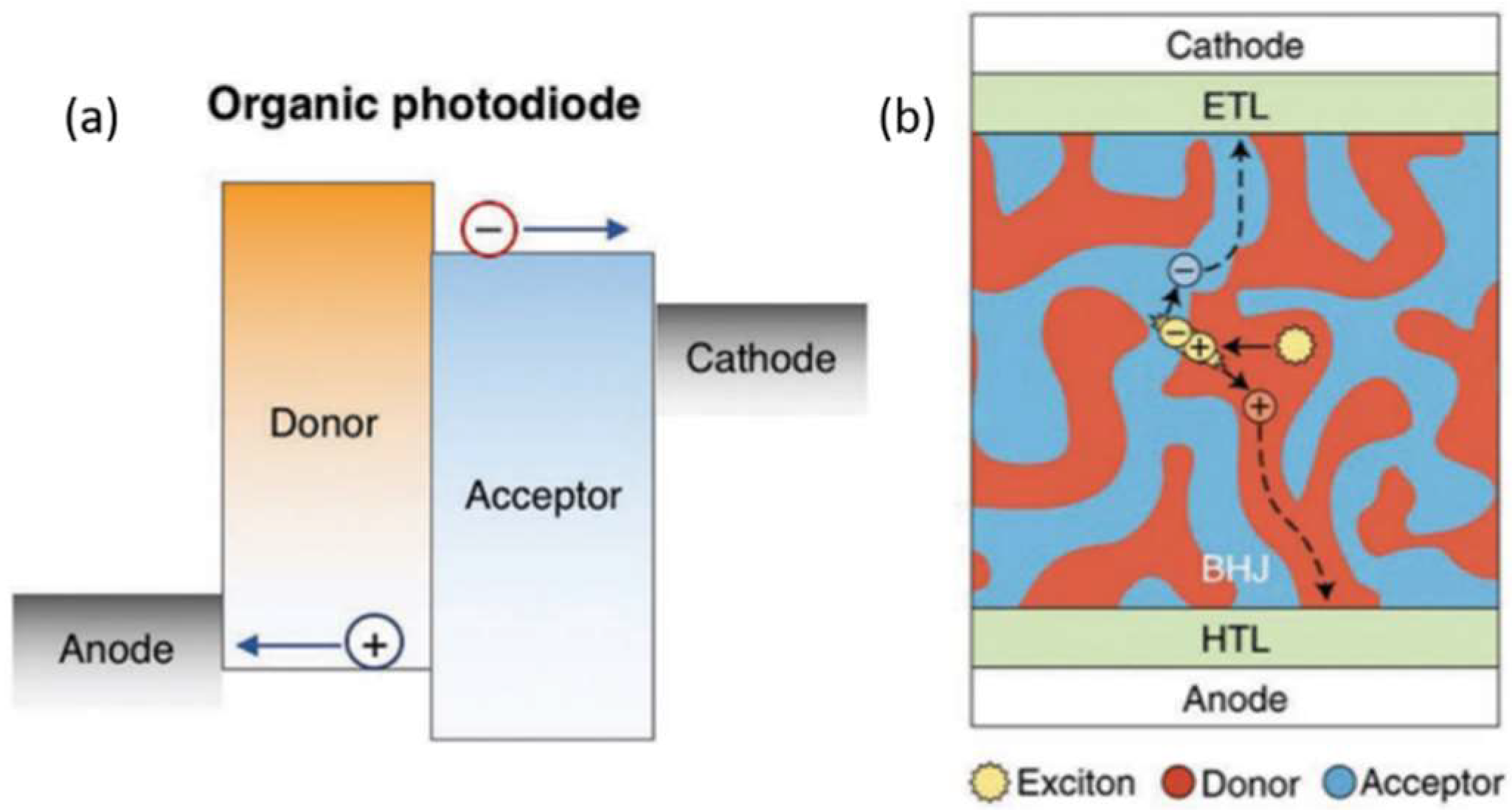


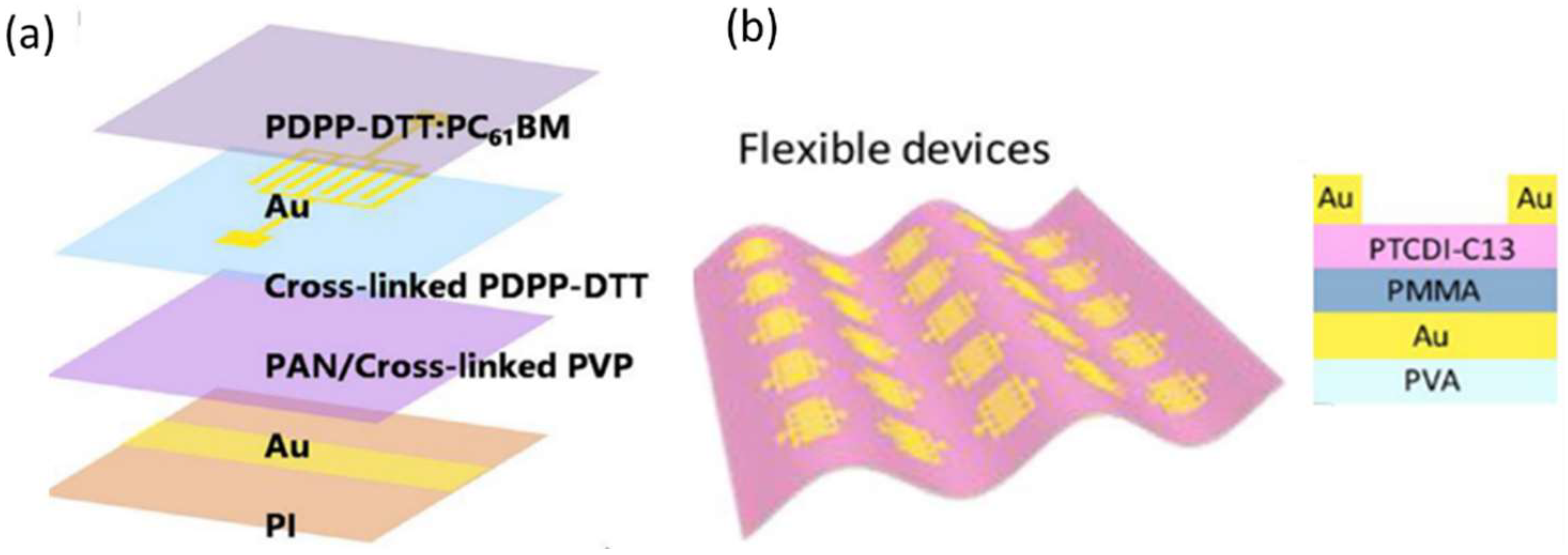



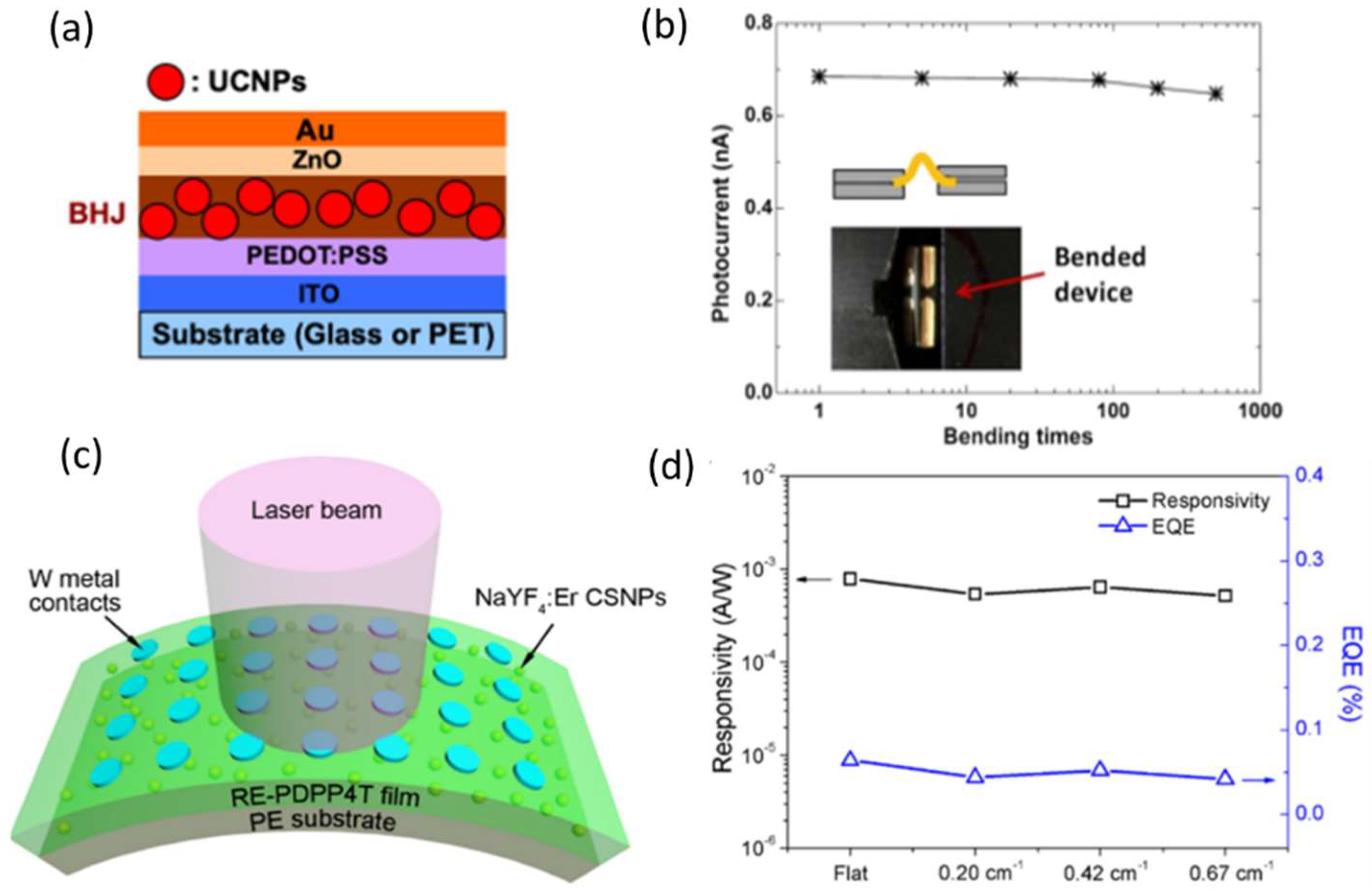
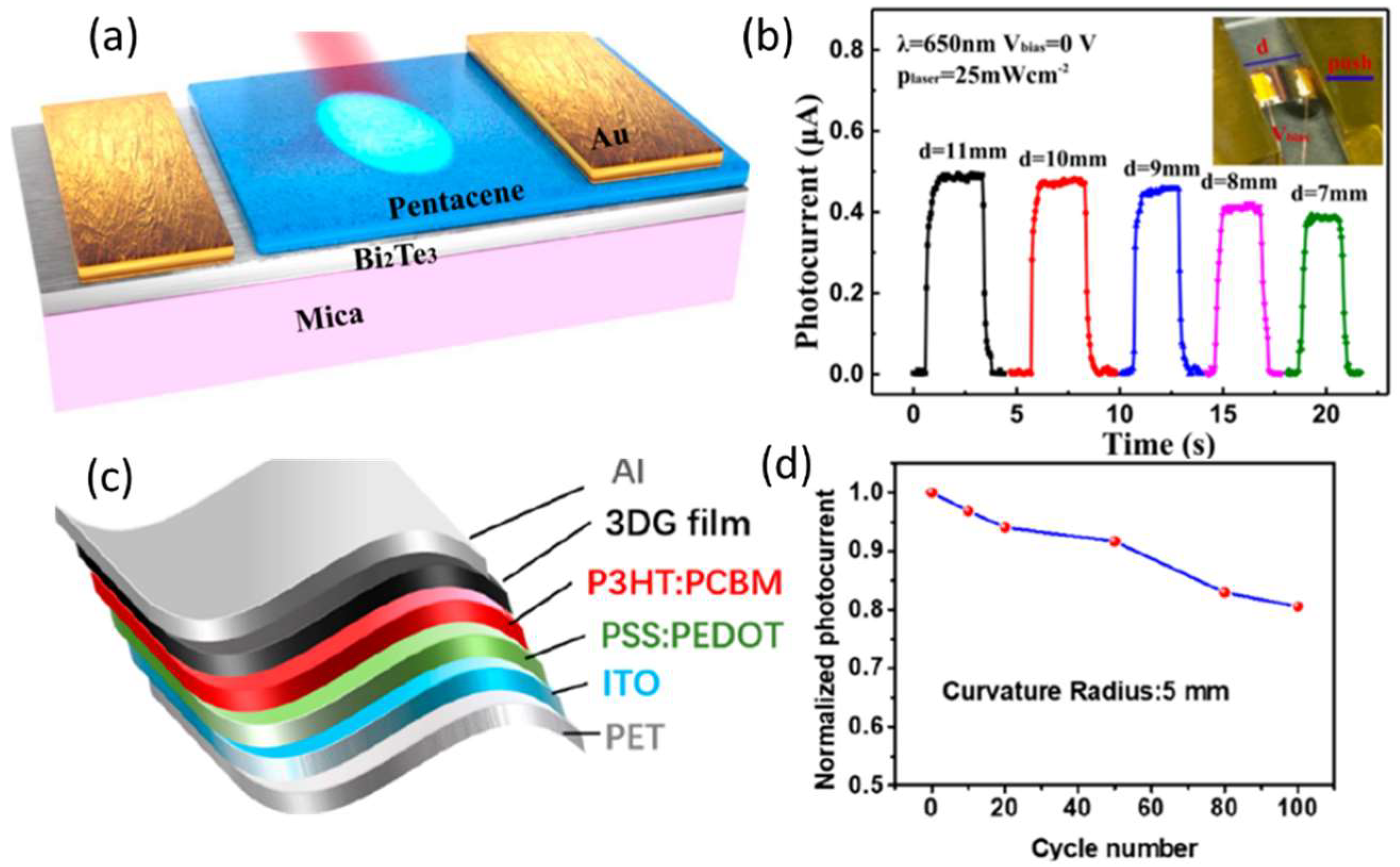
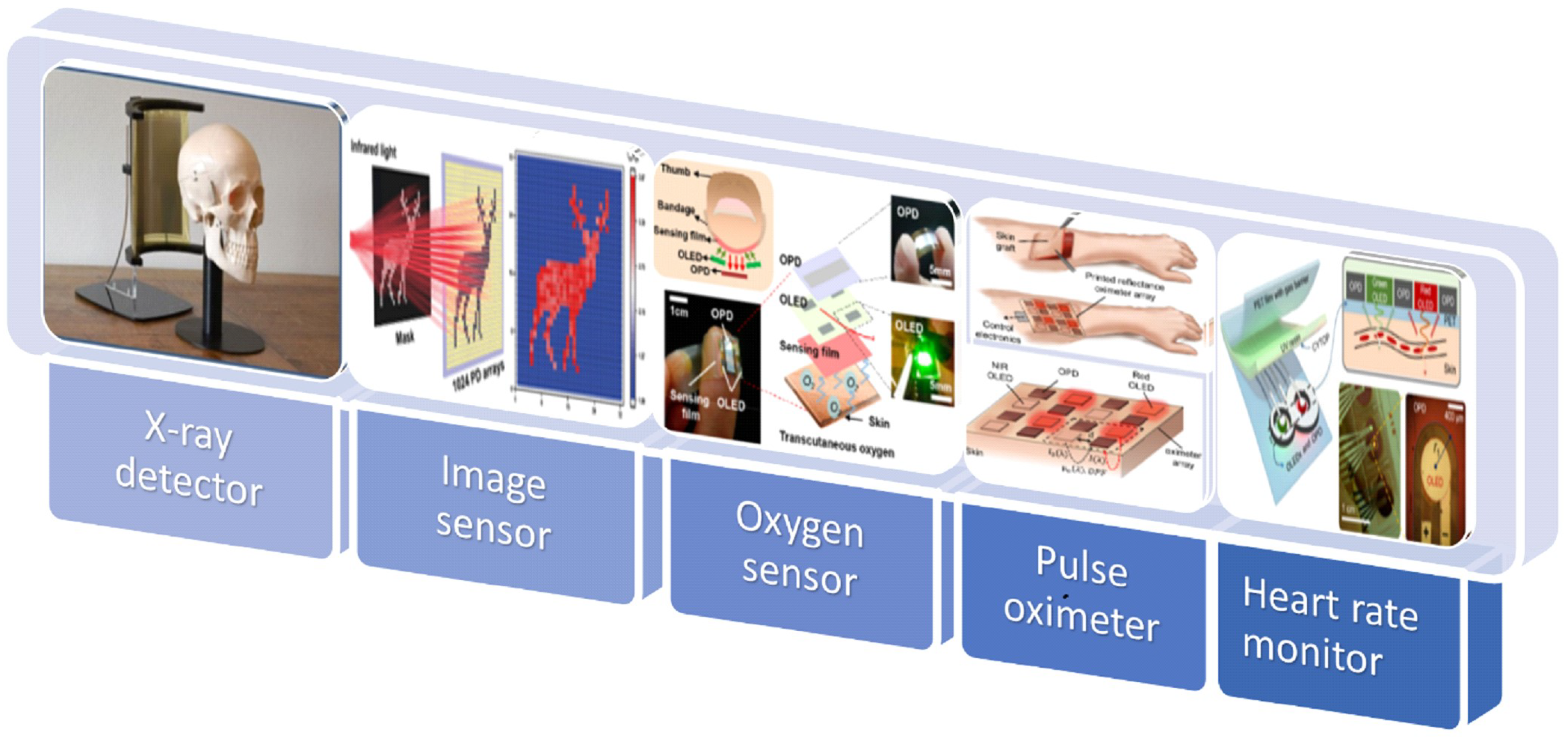
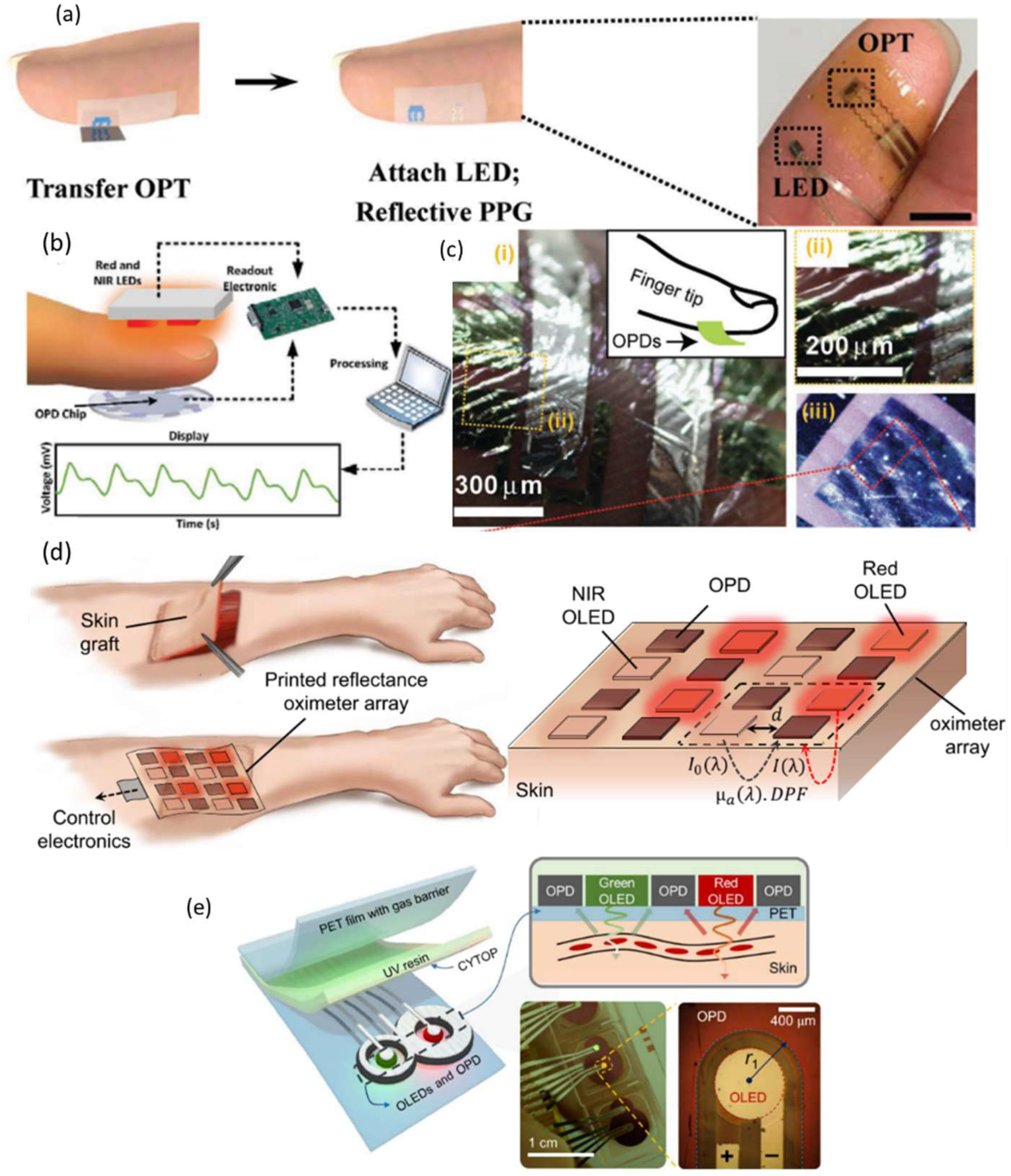
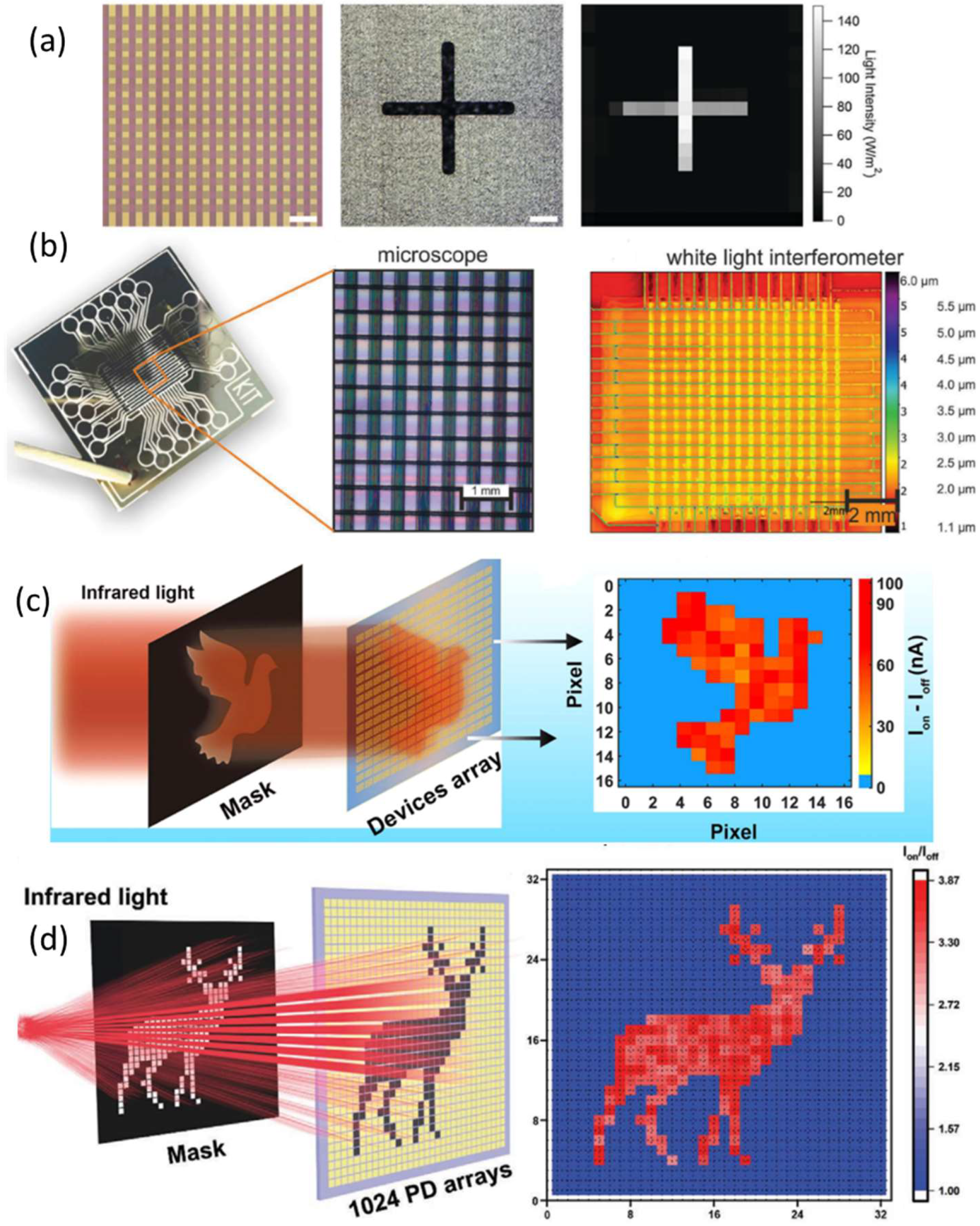

| Ref | Active Materials | Substrate | Device Type | Flexibility | Responsivity | Detectivity | Response Time |
|---|---|---|---|---|---|---|---|
| [36] | Tin-based perovskite/PEDOT:PSS | PI | PT | Rb = 8 mm 300 times | ∼8.7 × 105 A/W | - | - |
| [37] | P3HT:PC70BM | PET | PM | 1000 bending at R = 8.54 mm | 388.4 A/W | - | 210 ms |
| [38] | PCDTBT:PCBM | PI | Photodiode | - | 0.21 A/W | 3 × 1012 Jones | - |
| [39] | PBTB | PET | PC | 2000 bending at theta = 120 degree | 0.9 A/W | 1.8 × 1010 Jones | 900 ms |
| [40] | TQ1:PNDI-T10 | PET | Photodiode | - | 0.17 A/W | 1011 Jones | - |
| [41] | D18:Y6 and D18/Y6 | PET | Photodiode | Bending with R = 11 mm | 0.35 A/W | 9.39 × 1011 Jones | 0.013 ms |
| [42] | P3HT:o-IDTBR | PET | Photodiode | 1000 bending at R = 1 cm | - | - | - |
| [43] | PBDTTT-OFT:IEICO-4F | PI | Photodiode | 1000 bending at R = 25 micrometer | 11.9 A/W | 1.7 × 1015 Jones | 0.037 s |
| [44] | PDPP-DTT:PC61 BM/cross-linked DPP-DTT | PI | PT | Bending with R = 6 mm | 150 A/W | - | 0.15 s |
| [45] | D18 | PET | PT | 2000 bending at R = 10 mm | 10 A/W | 1.7 × 1013 Jones | few milliseconds |
| [46] | In2O3/PTPBT-ET | PI | PT | 1000 bending with R = 5 mm | 20 A/W | 1.4 × 1012 Jones | 5 ms |
| [47] | SQ-H:PC61BM | PET | Photodiode | - | 0.2 A/W | 9 × 1010 Jones | - |
| [48] | MAPbI3 MWs covered by an assembled P3HT | PET | Photodiode | 100 bending with theta = 90 degree | 400 A/W | - | 12 ms |
| [49] | SEBS: P3HT: ICBA | Silicone elastomer PDMS | Photodiode | - | 0.006 A/W | 2.3 × 1010 Jones | 0.06 ms |
| [50] | P3HT:PCBM/3DG | PET | Photodiode | 100 bending with R = 5 mm | 5.8 × 105 A/W | 3 × 1015 Jones | 24 ms |
| [51] | PTB7-Th:COTIC-4F | PEN | Photodiode | 100 bending with R = 7.5 mm | ≈0.42/A/W | 1.25 × 1013 Jones | 0.021 ms |
| [52] | PEDOT:PSS/SnSe2 | ITO/PET | Photodiode | 3000 bending | 0.73 A/W | - | 16 ms |
| [53] | ZnO/P3HT | PET | Photodiode | - | 156 µA/W | 0.74 × 109 Jones | 40 ms |
| [54] | RNA | PET | Photodiode | Bending with theta = 150 degree | 14.99 µA/W | 5.23 × 107 Jones | 5 s |
Publisher’s Note: MDPI stays neutral with regard to jurisdictional claims in published maps and institutional affiliations. |
© 2022 by the authors. Licensee MDPI, Basel, Switzerland. This article is an open access article distributed under the terms and conditions of the Creative Commons Attribution (CC BY) license (https://creativecommons.org/licenses/by/4.0/).
Share and Cite
Anabestani, H.; Nabavi, S.; Bhadra, S. Advances in Flexible Organic Photodetectors: Materials and Applications. Nanomaterials 2022, 12, 3775. https://doi.org/10.3390/nano12213775
Anabestani H, Nabavi S, Bhadra S. Advances in Flexible Organic Photodetectors: Materials and Applications. Nanomaterials. 2022; 12(21):3775. https://doi.org/10.3390/nano12213775
Chicago/Turabian StyleAnabestani, Hossein, Seyedfakhreddin Nabavi, and Sharmistha Bhadra. 2022. "Advances in Flexible Organic Photodetectors: Materials and Applications" Nanomaterials 12, no. 21: 3775. https://doi.org/10.3390/nano12213775
APA StyleAnabestani, H., Nabavi, S., & Bhadra, S. (2022). Advances in Flexible Organic Photodetectors: Materials and Applications. Nanomaterials, 12(21), 3775. https://doi.org/10.3390/nano12213775






